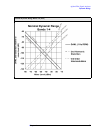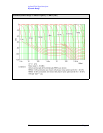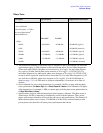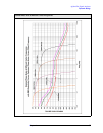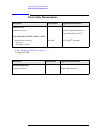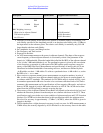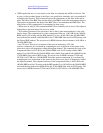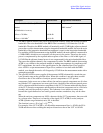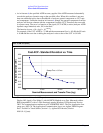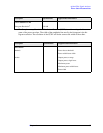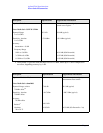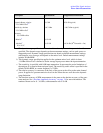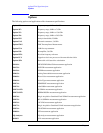
Chapter 1 59
Agilent EXA Signal Analyzer
Power Suite Measurements
i. To meet this specified accuracy when measuring mobile station (MS) or user equipment (UE)
within 3 dB of the required −33 dBc ACPR, the mixer level (ML) must be optimized for accu-
racy. This optimum mixer level is −22 dBm, so the input attenuation must be set as close as
possible to the average input power − (−19 dBm). For example, if the average input power is
−6 dBm, set the attenuation to 16 dB. This specification applies for the normal 3.5 dB
peak-to-average ratio of a single code. Note that if the mixer level is set to optimize dynamic
range instead of accuracy, accuracy errors are nominally doubled.
j. ACPR accuracy at 10 MHz offset is warranted when the input attenuator is set to give an aver-
age mixer level of −14 dBm.
k. In order to meet this specified accuracy, the mixer level must be optimized for accuracy when
measuring node B Base Transmission Station (BTS) within 3 dB of the required −45 dBc
ACPR. This optimum mixer level is −19 dBm, so the input attenuation must be set as close as
possible to the average input power − (−22 dBm). For example, if the average input power is
−5 dBm, set the attenuation to 14 dB. This specification applies for the normal 10 dB
peak-to-average ratio (at 0.01% probability) for Test Model 1. Note that, if the mixer level is
set to optimize dynamic range instead of accuracy, accuracy errors are nominally doubled.
l. Accuracy can be excellent even at low ACPR levels assuming that the user sets the mixer
level to optimize the dynamic range, and assuming that the analyzer and UUT distortions are
incoherent. When the errors from the UUT and the analyzer are incoherent, optimizing
dynamic range is equivalent to minimizing the contribution of analyzer noise and distortion to
accuracy, though the higher mixer level increases the display scale fidelity errors. This inco-
herent addition case is commonly used in the industry and can be useful for comparison of
analysis equipment, but this incoherent addition model is rarely justified. This derived accu-
racy specification is based on a mixer level of −14 dBm.
m..Agilent measures 100% of the signal analyzers for dynamic range in the factory production
process. This measurement requires a near-ideal signal, which is impractical for field and cus-
tomer use. Because field verification is impractical, Agilent only gives a typical result. More
than 80% of prototype instruments met this “typical” specification; the factory test line limit is
set commensurate with an on-going 80% yield to this typical.
The ACPR dynamic range is verified only at 2 GHz, where Agilent has the near-perfect signal
available. The dynamic range is specified for the optimum mixer drive level, which is differ-
ent in different instruments and different conditions. The test signal is a 1 DPCH signal.
The ACPR dynamic range is the observed range. This typical specification includes no mea-
surement uncertainty.



